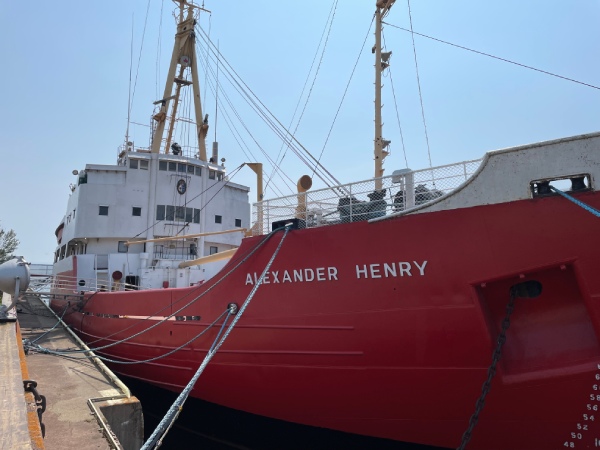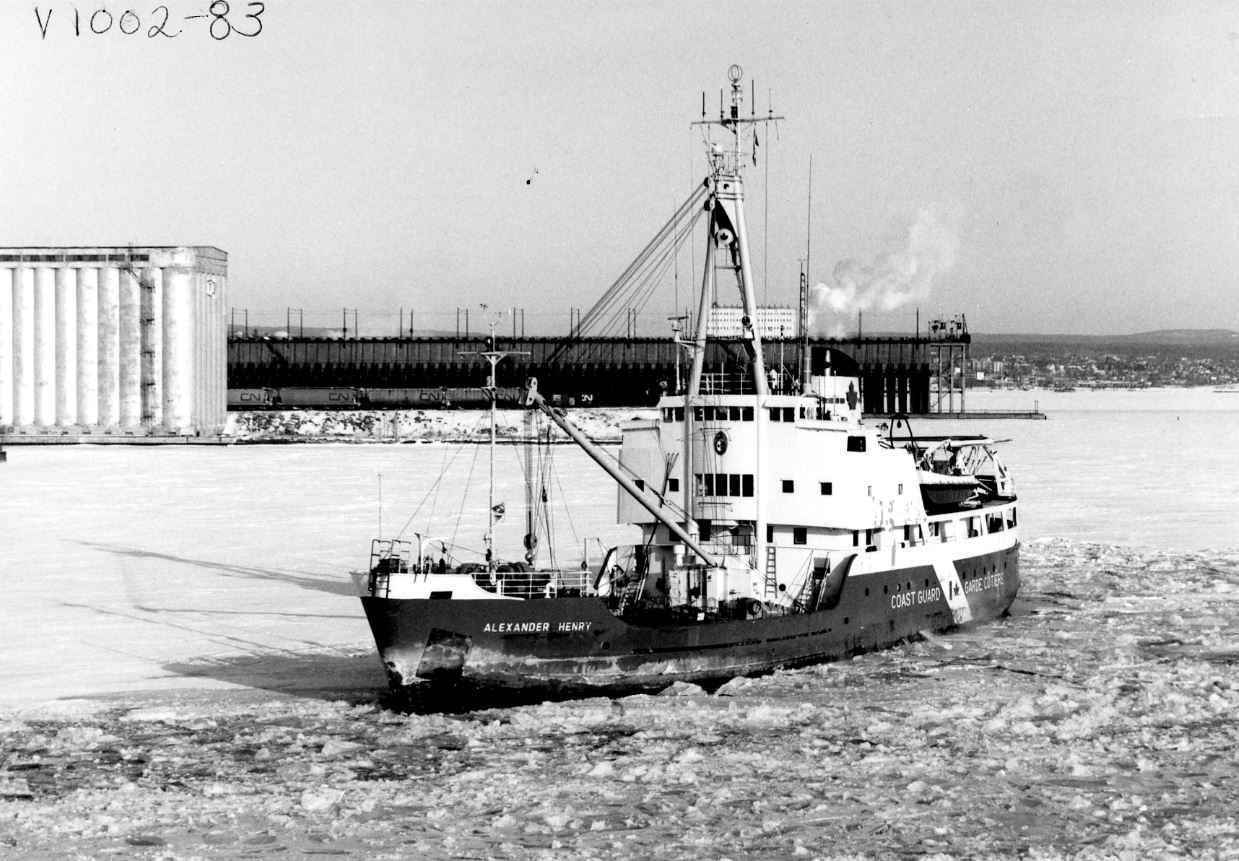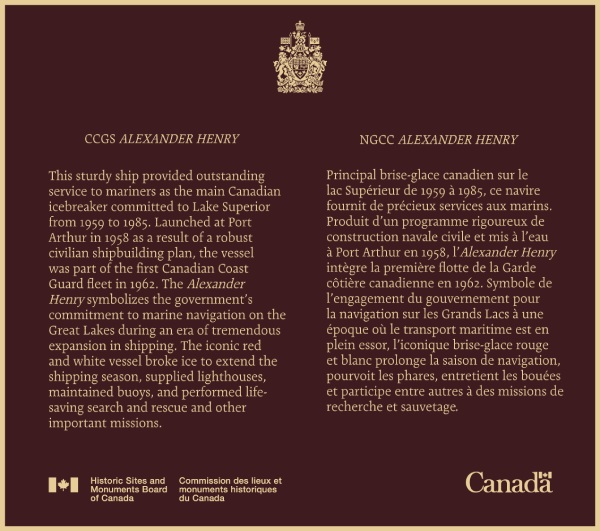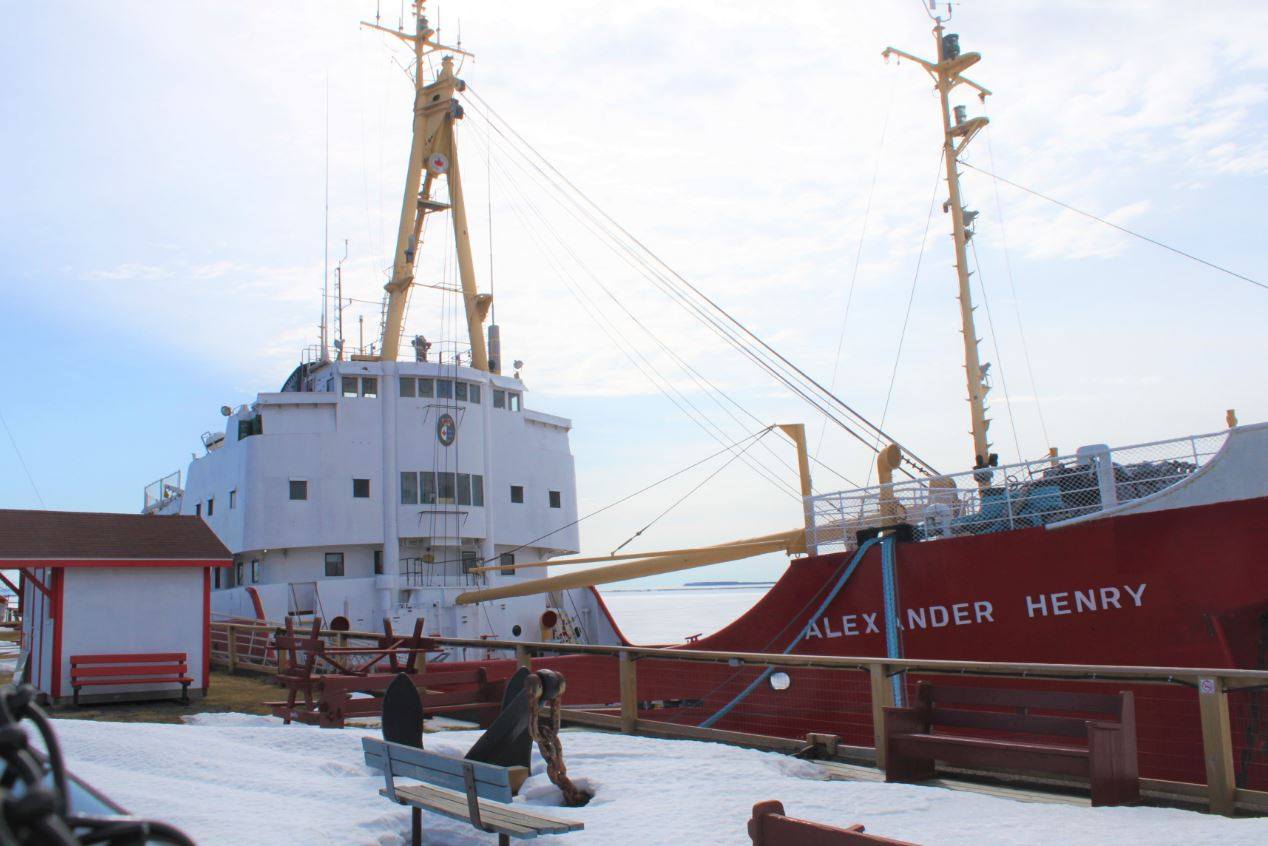CCGS Alexander Henry National Historic Site

© Parks Canada / Svenja Hansen
The former Canadian Coast Guard Ship (CCGS) Alexander Henry was designated as a national historic site in 2023.
Commemorative plaque: will be installed at 2460 Sleeping Giant Pkwy (Pool 6 Grounds), Thunder Bay, OntarioFootnote 1
CCGS Alexander Henry, Thunder Bay, Ontario
This sturdy ship provided outstanding service to mariners as the main Canadian icebreaker committed to Lake Superior from 1959 to 1985. Launched at Port Arthur in 1958 as a result of a robust civilian shipbuilding plan, the vessel was part of the first Canadian Coast Guard fleet in 1962. The Alexander Henry symbolizes the government’s commitment to marine navigation on the Great Lakes during an era of tremendous expansion in shipping. The iconic red and white vessel broke ice to extend the shipping season, supplied lighthouses, maintained buoys, and performed life-saving search and rescue and other important missions.
CCGS Alexander Henry

© George Lucas / CCG, courtesy of the Transportation Museum of Thunder Bay
The former Canadian Coast Guard Ship (CCGS) Alexander Henry is a retired light icebreaker, buoy tender, and navigational aid ship that served on the Great Lakes from 1959 to 1985. As the main Canadian icebreaker committed to Lake Superior, and the first government-owned icebreaker there, Alexander Henry provided exemplary service to marine navigation, breaking ice to extend the shipping season at the Lakehead. The ship’s critical duties included supplying lighthouses and escorting lighthouse keepers, maintaining buoys, and performing life-saving search and rescue and other important missions. The vessel represents the commitment of the Government of Canada to marine navigation in a period of expanding shipping and trade.
Designed by the Montréal naval architectural firm German & Milne, and built by the Port Arthur Shipbuilding Company, the ship was launched on 18 July 1958. The vessel was one of more than ten icebreakers ordered as part of a government shipbuilding program prompted by a post-war expansion of shipping and trade alongside concerns for a Canadian presence in the Arctic. Originally constructed for the Department of Transport’s Marine Services fleet, the ship was one of 49 large vessels incorporated into the Canadian Coast Guard upon that agency’s inception in 1962 and repainted the service’s iconic red and white.

Alexander Henry is part of a long history of government support for marine navigation and is an excellent representative of this activity on the Great Lakes. The Coast Guard was organized to address the increasing complexities of tasks associated with safe navigation. The ship was responsible for the safe passage of huge volumes of shipping enabled by the construction of canals and locks. Infrastructure development culminated in the St. Lawrence Seaway in 1959, which allowed full-sized ocean bulk carriers to travel the Upper St. Lawrence River and beyond, to all five of the Great Lakes. One of the vessel’s roles was to extend the shipping season as long as possible, breaking channels in the ice during the freeze-up in early winter and around break-up in the spring. Major bulk cargoes shipped on Lake Superior included grain, coal, iron ore, and pulpwood. The region became a major component of the Canadian economy. The ship also maintained navigational aids, bringing lighthouse keepers and supplies to the various light stations, and maintaining buoys during the shipping season. The vessel could be called to perform search and rescue missions whenever marine disaster struck. It also performed missions to support environmental response, scientific research, and hydrography. While the vast majority of Alexander Henry’s work was on Lake Superior, in the 1980s the ship sailed to the Newfoundland Region, where it helped tend navigational aids.
“The Board of Directors of the Transportation Museum of Thunder Bay (TMTB) is honoured that the former Canadian Coast Guard Ship, Alexander Henry - built in Thunder Bay and now a museum ship with TMTB - has been officially designated a national historic site in recognition of Alexander Henry's historical importance in Canadian maritime history.”

© Parks Canada / Will Pratt
The vessel was retired in July 1985, after which the former CCGS Alexander Henry became a museum ship. It was first exhibited at the Marine Museum of the Great Lakes at Kingston, where it was well maintained for more than three decades. The ship was purchased by the Lakehead Transportation Museum Society in 2017 and now hosts summer visitors at the Transportation Museum of Thunder Bay. The vessel is one of the best surviving examples of the government’s icebreaker construction program of the late 1950s, designed to meet Canada’s responsibilities off its coasts and on inland waters.
This press backgrounder was prepared at the time of the plaque unveiling in 2024.
The National Program of Historical Commemoration relies on the participation of Canadians in the identification of places, events and persons of national historic significance. Any member of the public can nominate a topic for consideration by the Historic Sites and Monuments Board of Canada.
- Date modified :